Military roads museum collections
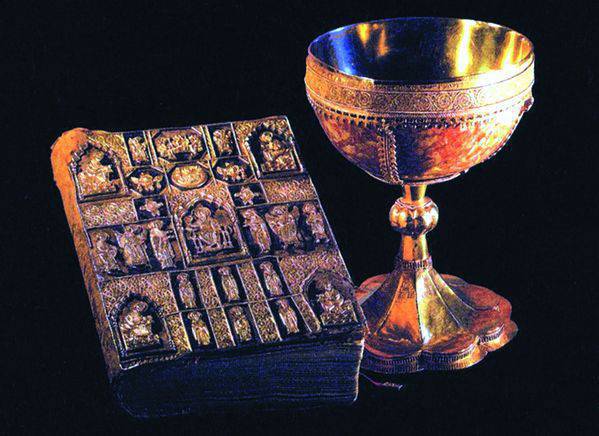
Moving and preserving in the conditions of evacuation of museum valuables during the Great Patriotic War is one of the dramatic and at the same time bright pages stories national culture. The striking events of the museum's military everyday life are still not fully understood.
German threat
The State Museum within the walls of the Trinity-Sergius Lavra was organized by 20 decree of 1920 on April 1, and by the 1940 decree of 1 of February 2 in February the entire territory of the Zagorsk 3 museum within the fortress walls of the Trinity-Sergius Lavra was declared the XNUMX preserve museum. From the regional subordination of the museum moved to the Office of Arts at SNK RSFSR and acquired the status of a museum-reserve of national importance. During the Great Patriotic War, security and evacuation work in the system of the Committee for Arts at the Council of People's Commissars of the USSR, which was in charge of art museums, was organized more efficiently than in the museum system Narkompros XNUMX.
Since the beginning of the war, the main task was to preserve the foundation of the museum’s collection, one of the richest treasures of Russia - the sacristy of the Trinity-Sergius Lavra. Values left the monastery not for the first time - even during World War 1812, the sacristy and the precious decoration of the Lavra churches were taken in two turns to Vologda, saving the treasure from being plundered by the French army4.
In 1941, the preparation for evacuation was carried out from the first days of the war. 27 June 1941 was adopted by a joint decision of the Central Committee of the CPSU (b) and the Council of People's Commissars of the USSR "On the procedure for the removal and deployment of human contingents and valuable property." 1 July went to the east the first trains with exhibits of the Hermitage and the Russian Museum. Deep in the rear, nine large repositories of evacuated museum valuables were created. In total, the 41 Art Museum, which was part of the Office of the Arts, was evacuated to the 21 Museum 5.
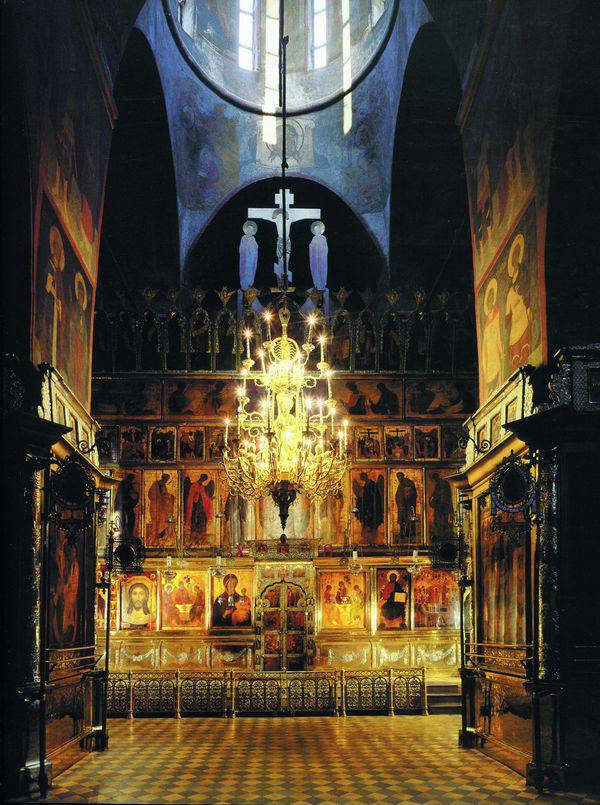
In Zagorsk Museum-Reserve to 1 July was determined the composition of the first ready to be sent boxes with exhibits. A total of 42 valuable cargo box was prepared - 1 category exhibits: items from precious metals, stones, pearls - church utensils, the core of the collection of icons and small plastics, unique works of old Russian sewing and church vestments, handwritten and printed books in precious salaries, including the oldest inventory of the monastery 1641
In each box, depending on the size of the exhibits, there were from 4 to 140 items. Separately were packed precious riza XVI-XVIII centuries. on the icon "Trinity" by Andrei Rublev and the so-called "Pearl" embroidered veil "Cross on Calvary" 1599, the contribution to the Trinity Monastery of Tsar Boris Godunov.
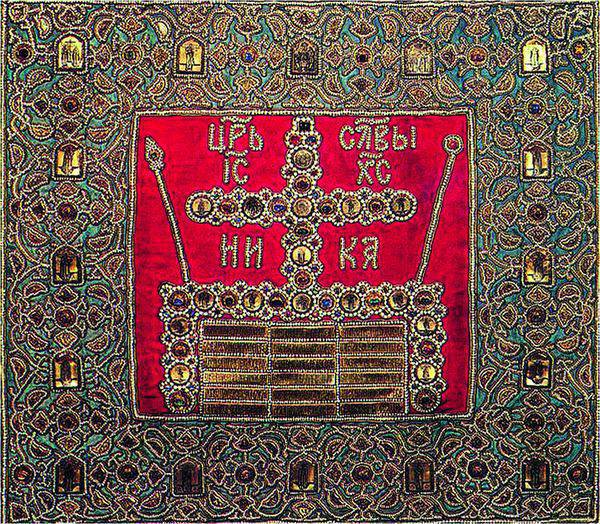
19 July 1941 was prepared for packaging, then placed in a separate box, a silver raku, inside of which the relics of St. Sergius of Radonezh were under three seals of the Zagorsk regional department of the NKVD.
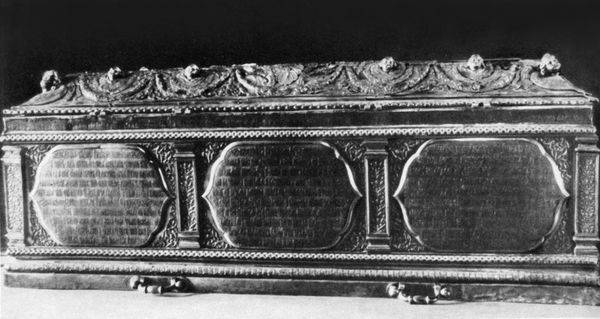
However, there is a version that the relics of Sergius of Radonezh were not fully evacuated. According to some information, the head of Sergius from 1920 to 1946 was kept outside the monastery, which was a consequence of her replacement in cancer after the public opening of the relics in April 1919. According to this version, the substitution itself was made by museum staff P.A. Florensky and Yu.A. Olsufiev in order to save the shrine. As a result of repeated movements in the autumn of 1941, the head of Sergius found herself in the church of the Vladimir Icon of the Mother of God in the village of Vinogradovo near Moscow (near Dolgoprudnaya station). Here, the shrine retained in the altar under the altar of the temple stayed until the summer of 1945. In accepting this version, we must inevitably take into account the circumstance arising from it that while the other relics of Sergius of Radonezh were in the rear, evacuated to the Urals as part of collections Zagorsk Museum in the summer of 1941, the head of Sergius in the most difficult days of the battle for Moscow remained practically on the front line (in early December, German troops approached Lobnya and reached the village of Vinogradovo, where cannonade was heard around the clock, 8 remained).
The last one was packed "silver from the Trinity Cathedral", i.e. The precious decoration of the crayfish and the altar of the cathedral is a whole complex of objects, including details of the throne and the canopy above the throne, details of the canopy and fencing of the crawfish, portable candlesticks, icon lamps, and candlesticks. In total, in those days, about 1300 items of the museum collection were sent to the rear.
It is known that at the beginning of the war major museums handed over a certain amount of their valuables for storage in government safes. In the Zagorsk Museum, a similar transfer took place in the summer of 1937, when more than 200 items were handed over for temporary storage of precious metals of the USSR Commissariat of Finance to Gokhran. Thus, throughout the war, these exhibits were in the care of the Commissariat and in May 1945 returned to the museum funds. Among them, the jewel of the collection, now on permanent display, is the precious miter of 1626.
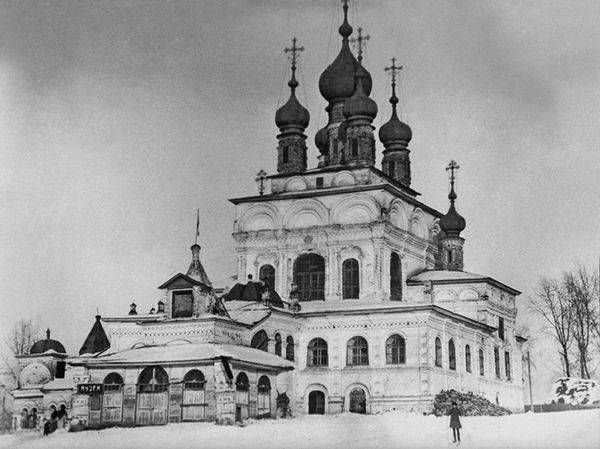
The secret is entrusted to Baltun
25 July 1941, on the basis of an order of the Office of Arts Affairs, the values of the Zagorsk Museum Reserve (42 sealed box) were deposited in the State Historical Museum. Transportation of cargo to a new storage location was carried out by water centrally in accordance with the general plan of evacuation of art museums.
Ways of following such "caravans" were classified, destinations, transportation details are known only to a limited circle of responsible persons. Among them was and. Director of the Russian Museum P.K. Baltun. On the basis of the memories he left, it is possible to restore the route of the "floating storage", which transported to the east the collections of several major museums. In the twenties of August, the "caravan" arrived in Gorky, in September, continued its journey along the Kama to Perm, where the boxes with the values of the Russian Museum and the State Tretyakov Gallery were left for storage. In the first half of October, the icy barge, breaking another 400 km, reached its destination - Solikamsk7.
It took a long time to unload and transport the museum cargo for seven kilometers to a temporary storage site. In Solikamsk, the “Zagorsk” exhibits were placed along with the valuables of the other nine evacuated museums and exhibitions (the Pushkin Museum of Fine Arts, the Museum of Oriental Cultures, the Museum of Ceramics and the Kuskovo estate, the Bakhrushin Central Theater Museum, and others) that arrived on the same barge in the building owned by the local history museum, the three-story summer Trinity Cathedral of the 17th century. The new storage was spacious in size - about a thousand square meters, but unheated8.
The Zagorsky Museum-Reserve has become one of ten museums, the responsibility for the safety of evacuated valuables of which was assigned to the management of the Russian Museum9. On October 22, the cargo safely delivered by barge N 3805 was officially handed over by the director of the Zagorsk Museum I.Z. Ptitsyn deposited by the director of the branch of the Russian Museum in the evacuation of P.K. Baltun and the keeper of a special cargo of museums in Solikamsk, OM Postnikova-Pankova10.
Solikamsk branch of the Russian Museum
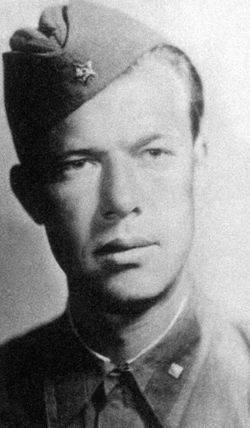
OF. Ptitsyn for some time headed the Solikamsk branch of the branch of the Russian Museum as the deputy PK Baltuna11. Under his command were two representatives of evacuated museums - O.M. Postnikov-Pankova from the Kuskovo Museum and P.Ya. Cozan. This small team had to ensure the safety of more than 400 boxes, most of the contents of which were 1 category exhibits - the most valuable parts of the funds of the largest museums in the country.
Some time was required for the employees to place hundreds of boxes and properly organize their storage in a new place. The containers were placed in museums and the type of materials stored in them. A specially designed system of passages between the boxes and topographical indexes should have provided free access to each of them separately for the necessary inspections of the contents. The usual museum life was gradually debugged: a system of duties and regular rounds was established, and a militarized guard was organized.
However, already at the beginning of 1942, one of the first serious inspections of the repository established that the allocation of funds in Solikamsk should be recognized as a “big, unacceptable mistake”. The main reason for this conclusion was the absence of a heating system in the cathedral, the temperature in which fell to frost degrees 20. Street temperature indicators in the autumn-winter 1941 g. Ranged from 30 to 50 degrees of frost. In the rooms of the employees who were within the storage, the walls were half a meter from the floor covered with snow and ice 12.
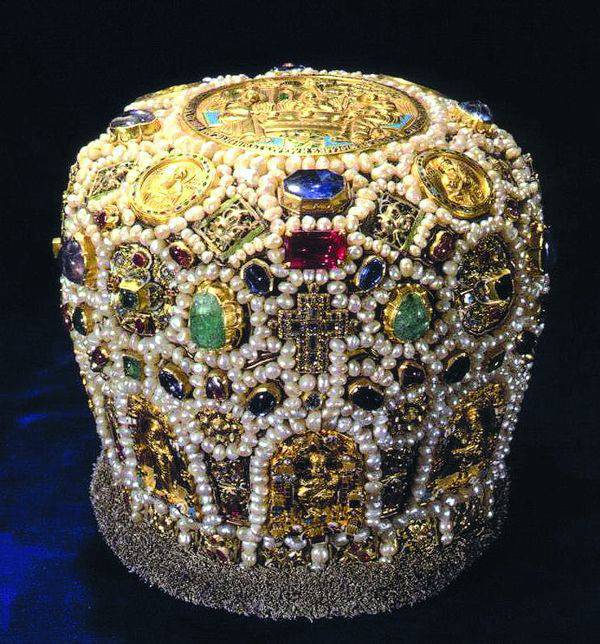
Such unacceptable conditions could have the most detrimental effect on the safety of objects during the spring thaw period, which entails dampness of the room. The management sounded the alarm about the condition of the most fragile, most exposed to the negative external conditions of the exhibits - papyrus, manuscripts, gold-woven and silk fabrics.
As a possible rescue measure, options were considered for exporting part of the collections to the places most suited to storage conditions: to the storage facilities of Novosibirsk and Perm. Thus, the collection of fabrics of the Zagorsk Museum-Reserve was supposed to be transported to Novosibirsk, where parts of the funds of the Pushkin Museum of Fine Arts were already stored Pushkin and the Museum of Oriental cultures. At the same time, precious metal objects were considered possible to leave in Solikamsk. Fortunately, understandable concerns were later not justified and the significant deterioration in the condition of the monuments was avoided.
The above explains why, in subsequent wartime, measures to ensure the conditions of storage and to control the safety of exhibits were of paramount importance for the displaced collections. Within the framework of this activity, selective opening of boxes with valuables was carried out regularly.
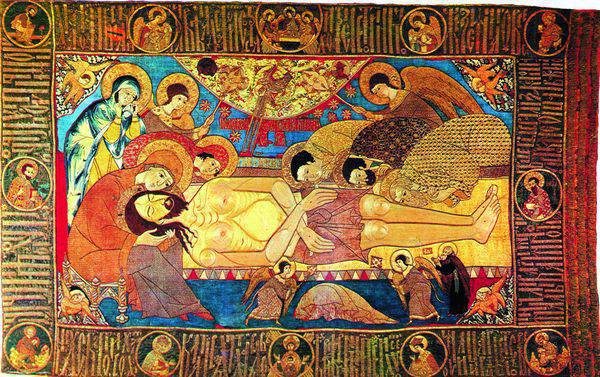
The most vulnerable to preservation for the Zagorsk Museum on the results of inspections were sewing monuments. Selective opening of the boxes in August-September 1942 showed the presence of moisture inside the container with the four ancient shrouds 13 stored on the shaft. Humidity, according to the experts of the Russian Museum, appeared as a result of a long (more than a year) exposure of the exhibits in a tight package without sufficient air access in an unheated room14.
Storage conditions evacuated valuables are constantly monitored by the leadership department. Noting in general the satisfactory conditions of the exhibits of the Zagorsk Museum-Reserve in Solikamsk, the Office of Arts in 1943 was forced to state that "long-term preservation of the museum's most valuable fabrics in conditions of the atmosphere impregnated with chemical plant wastes is not safe for their preservation." The general condition of the museum collections exported to the east in 1941 by this time forced the Arts Department to raise the question of their immediate re-evacuation of 15.
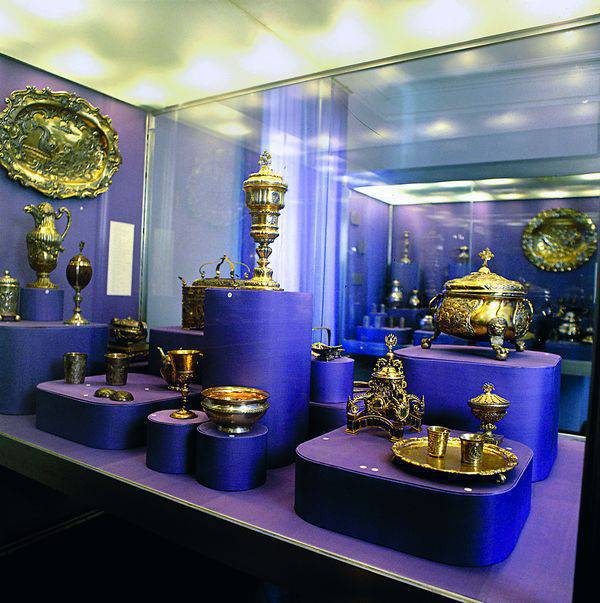
In November, 1942, the inspection of the exhibits was carried out directly by the employees of the Zagorsk Museum-Reserve A.M. Kurbatova and N.M. Prasolova, sent for this purpose in Solikamsk. Additionally, the contents of the boxes were examined by representatives of the Russian Museum in the spring of 1943. At each opening, in addition to checking availability, the necessary preventive measures were taken - airing, drying, dusting, repacking the exhibits.
Return to the monastery
Largely due to timely measures taken in November 1944, having survived the difficulties of re-evacuation, the museum’s values (along the Solikamsk-Perm-Kirov-Moscow railway route) were returned to the walls of the monastery, according to the final inspection report, 16. Significant loss and damage was not identified. Based on the returned exhibits in the summer of 1946, the Zagorsk Museum-Reserve was the first to open after the 1920s. art exposition "Old Russian art and culture of the XV-XVII centuries."
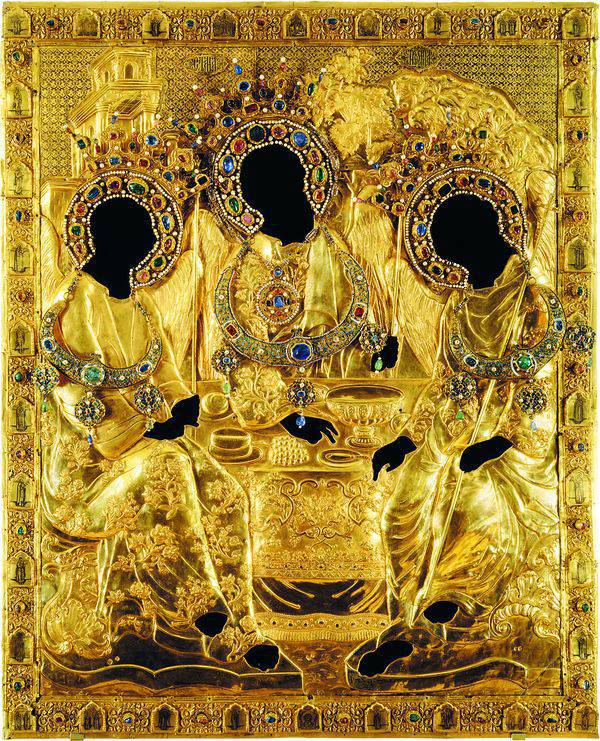
The evacuation of the museum exhibits were only a small part of its collection (the priority here was for precious metals and a collection of sewing). As in many other museums, the export of valuables for various reasons was not carried out in full. After the start of the counteroffensive of the Soviet troops near Moscow, it was suspended. For several years, the Zagorsky Museum has kept unpackaged books, icons of sacristy collection and the iconostasis of the Trinity Cathedral of the XV-XVII centuries. (first of all - icons of the epoch of Andrei Rublev) - a unique icon ensemble, the only Russian iconostasis of the 15th century preserved in its original form. At least 1941 boxes were hurriedly prepared for dispatch by the second line in October 32, in 15 of which there was the full iconic decoration of the Trinity Cathedral of the Lavra. These rare works of ancient Russian art survived with the museum the most critical time, when the front in November 1941 was held only in 35-40 km from Zagorsk. And only at the end of November 1941, after the defeat of the German units in the Yakhroma region, the threat of the capture of Zagorsk was removed 17.
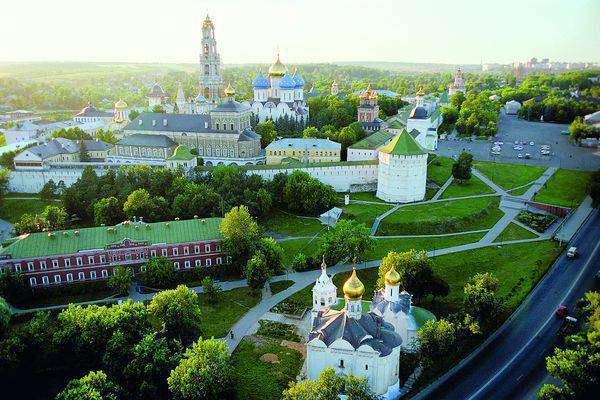
The finding of the Zagorsky Museum-Reserve under the authority of the Office for Arts under the SNK of the RSFSR directly affected the timeliness of the evacuation. Before the outbreak of the war, the necessary inventory of the main part of the assembly was carried out, and the exhibits intended for the primary evacuation of the 18 were timely allocated. All this has saved time and in the shortest possible time to send exhibits to the rear.
1. From 1930 to 1991, the museum within the walls of the Trinity-Sergius Lavra was called the Zagorsk Museum by the name of the city (from 1940 it was called the Museum-Reserve).
2. Culture in the regulations of the Soviet government. M., 2011. T. 5. C. 26.
3. Simkin MP Soviet museums during the Great Patriotic War // Proceedings of the Research Institute of Museology. Issue Ii. M., 1961. C. 203; Fatigarova N.V. Museum business in the RSFSR during the Great Patriotic War (aspects of state policy) // Museum and Power. M., 1991. C. 189.
4. Zaritskaya O.I. Salvation of Lavra values during World War 1812. // Church and society at the turning points of history. Sergiev Posad, 2014. C. 253-263.
5. Maksakova L.V. Culture of Soviet Russia during the Great Patriotic War. M., 1977. C. 39, 44.
6. Komarova L.S. The fate of the head of St. Sergius of Radonezh. M., 2006. C. 360.
7. Baltun P.K. Russian Museum - evacuation, blockade, restoration. M., 1980. C. 42-51.
8. Department of written sources of the State Historical Museum. F.54. D. 1108. L. 1.
9. Gorelova S.I. The State Russian Museum during the Great Patriotic War (1941-1945). Artistic heritage. Storage, research, restoration (Moscow). 1980. N 6 (36). C. 178-179.
10. Archive of the accounting department of the Sergiev Posad Museum-Reserve (AOUSPMZ). Op. 2. D. 62. L. 84.
11. In the spring of 1942, I.Z. Ptitsyn was drafted into the ranks of the Navy and subsequently died at the front.
12. RGALI. F. 962. Op. 11. D. 323. L. 5-9.
13. The shroud is a sewn image of the composition “The position of Christ in the grave”, the subject of passionate worship (entrusted in the temple to the symbolic coffin of Christ in Holy Week).
14. AOUSPMZ. Op. 2. D. 65. L. 7.
15. RGALI. F. 2075. Op. 1. D. 127. L. 43. Resolution SNK USSR on the re-evacuation of art collections of museums in Moscow and Moscow region 4 was adopted in October 1944. The corresponding order of the Committee on Arts Affairs of the USSR SNK was followed in October 9 1944. To October 12, the funds of the Solikamsk deposit were ready for re-evacuation.
16. AOUSPMZ. Op. 2. D. 74. L. 29. Accompanying the museum cargo throughout the entire route was the 31 guard of a separate armored train division of the NKVD troops guarding the railways.
17. On the military everyday life of the frontline Zagorsk see: Sergiev Posad district in the mirror of the history of the XX century. Sergiev Posad, 2013. CH 1. C. 73-94.
18. Presumably, this work was carried out in the museum in September 1940 with the participation of specialists from the Russian Museum, where similar events were carried out earlier.
Information